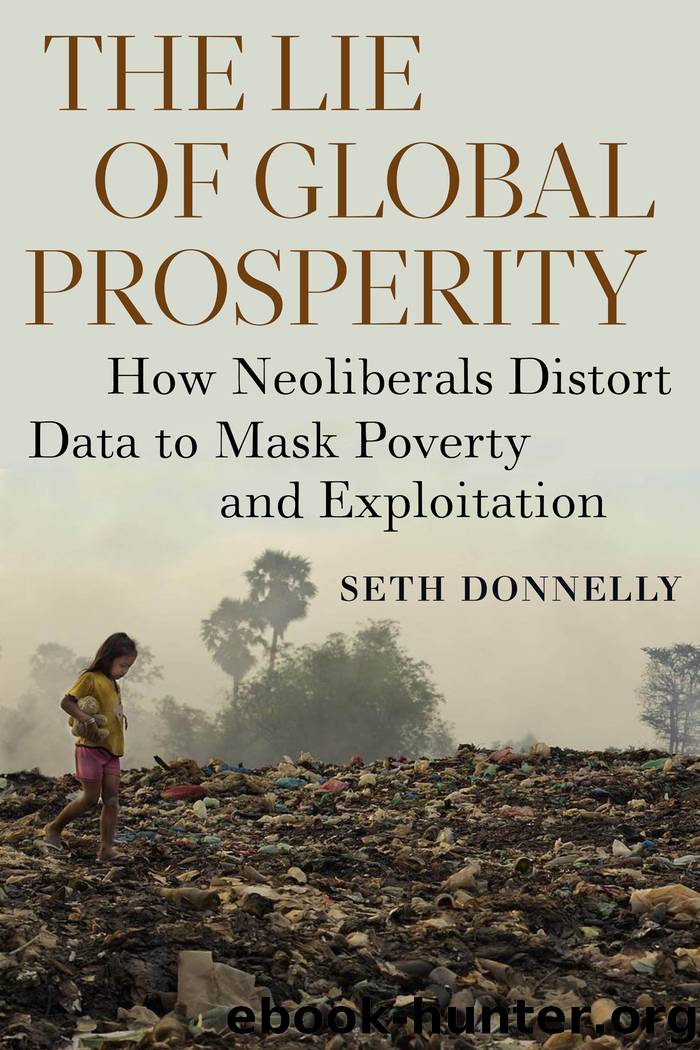The Lie of Global Prosperity: How Neoliberals Distort Data to Mask Poverty and Exploitation by Seth Donnelly

Author:Seth Donnelly
Language: eng
Format: epub
Publisher: Nyu Press
Published: 2019-02-18T16:00:00+00:00
THE DECLINE OF THE DOLLAR
In the 1960s, the Japanese and West German economies recovered, but the U.S. share of the global economy began to modestly decline, in part due to massive spending on the Vietnam War. Some countries in the OECD began to sense that the dollar was overvalued. For this reason, Switzerland and France moved to redeem millions of their dollars for gold, raising the danger of a run on the dollar (which was a serious concern, given that the U.S. government did not have enough gold reserves to redeem all dollars held by foreign central banks). In early 1971, Germany left the Bretton Woods system, allowing the deutsche mark to float in relation to the dollar. These events were the background for the famous “Nixon shock” of August 15, 1971. Claiming that his aim was to protect the dollar from “attacks of international money speculators,” Nixon announced that greenbacks would no longer be backed by gold, effectively ending the Bretton Woods system of fixed exchange rates.104
Now that the dollar had lost its backing in gold, what would protect its value, both nationally and internationally? Would it continue to be the international reserve currency? In fact, the dollar did depreciate considerably after Nixon’s decision. Nevertheless, in 1973 the Organization of Petroleum Exporting Countries announced an oil embargo. The aim was ostensibly to punish the West for supporting Israel in the Yom Kippur War, but the embargo was surely also intended to boost oil prices, which had not risen proportionally with other major commodities. It proved effective. By 1974, the price of oil had quadrupled.
In these years, Henry Kissinger and other members of the Nixon administration consolidated a “special relationship” with the Saudi Arabian monarchy that would prove determinative in future decades. The deal struck was that Saudi Arabia would sell oil for dollars and then use part of the excess dollars, the so-called petrodollars, to purchase U.S. Treasury bonds, thereby boosting the value of the dollar and enabling the U.S. government to easily borrow money. The U.S. Saudi Arabian Joint Commission on Economic Cooperation, founded in June 1975, was the formal recognition of this deal.105 In exchange for Saudi cooperation, the U.S. government provided the monarchy with technology (especially weapons) and infrastructure investment. Historian Greg Grandin argues that Kissinger’s deal with the Saudis was a replay of the relationship forged earlier with the Shah of Iran. By 1975, the United States had “more than a trillion dollars’ worth of military agreements with Riyadh.”106 The United States got the Saudis to pressure other OPEC countries to standardize the sale of oil in dollars. In effect, oil replaced gold as the dollar’s backing in the emerging international system.
It is still debated whether the Nixon administration was complicit in the oil crisis, helping to engineer it to weaken economic competition from Japan and Germany. What is undeniable, however, is that the administration successfully leveraged the crisis into an opportunity to solidify the dollar as the world’s reserve currency for oil.107 At the
Download
This site does not store any files on its server. We only index and link to content provided by other sites. Please contact the content providers to delete copyright contents if any and email us, we'll remove relevant links or contents immediately.
The Secret History by Donna Tartt(18849)
The Social Justice Warrior Handbook by Lisa De Pasquale(12142)
Thirteen Reasons Why by Jay Asher(8796)
This Is How You Lose Her by Junot Diaz(6795)
Weapons of Math Destruction by Cathy O'Neil(6146)
Zero to One by Peter Thiel(5686)
Beartown by Fredrik Backman(5599)
The Myth of the Strong Leader by Archie Brown(5425)
The Fire Next Time by James Baldwin(5249)
How Democracies Die by Steven Levitsky & Daniel Ziblatt(5128)
Promise Me, Dad by Joe Biden(5087)
Stone's Rules by Roger Stone(5026)
A Higher Loyalty: Truth, Lies, and Leadership by James Comey(4845)
100 Deadly Skills by Clint Emerson(4840)
Rise and Kill First by Ronen Bergman(4704)
Secrecy World by Jake Bernstein(4646)
The David Icke Guide to the Global Conspiracy (and how to end it) by David Icke(4626)
The Farm by Tom Rob Smith(4438)
The Doomsday Machine by Daniel Ellsberg(4416)
